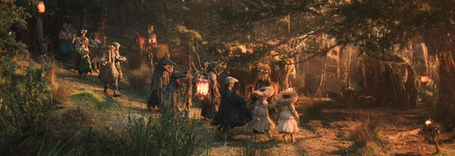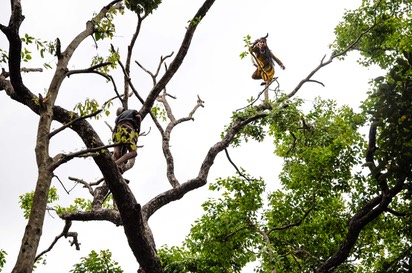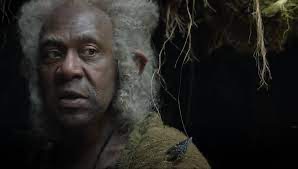As always, this is cross-posted from my livejournal/dreamwidth journal. All citations are taken from the Folio hardcover edition of Lord of The Rings. All linked essays and images are the property of their creators)
Among other criticisms of TROP. I’ve heard it said the Harfoots are not Hobbits. They’re mean! They have no sense of community! They abandon their own and laugh at their misfortunes! I can certainly see how a casual viewer would think this, but is it true the Harfoots we meet in the show bear no relation to the Hobbits we know and love? And is it true—as I’ve also read (Brad Deveraux’s very thought-provoking essay can be found at this link: https://acoup.blog/2022/12/16/collections-why-rings-of-powers-middle-earth-feels-flat/)--that their nomadic way of life makes no sense and has no similarity to actual nomadic cultures?
In both cases, I would answer no. The Harfoots strike me as extremely probable Hobbit ancestors. And their way of life actually tells us a lot about who they are, what they value, and why.

Let’s start with two vivid expressions of Harfoot culture. The first is the oft-repeated mantra, “Nobody goes off trail, and nobody walks alone.” This is drummed into the heads of Harfoot children, to the extent that they use it as a call and response during one of their major festivals. What does it mean, though, and how does it play out in the show?
We see that Harfoots disguise themselves and stay away from other peoples. They also migrate according to the seasons, coming to various places of bounty—abandoned farmlands, a forest full of mushrooms, an orchard—when the natural resources there are most available to them. In addition, they hunt for small game—frogs, fish, snails—and keep birds and rabbits, presumably for meat, eggs, and hair for yarn. We don’t see any wheelwrights, carpenters, or clothmakers, but we do see skillful use of natural materials—reeds, leaves, bark, etc.—to make disguises. And the existence of the wheels, which are treasured possessions, argues for the existence of wheelwrights, etc.
So who are the Harfoots? A clannish small people, good observers of the natural world, whose main goal in life, other than staying together and staying fed, seems to be avoiding notice. Their special skill is vanishing. In this, they are similar to their Hobbit descendants; in his prologue, Tolkien says, “They possessed from the first the art of disappearing swiftly and silently (prologue, page 15 of FOTR)
But why is it so important for the Harfoots to avoid notice?
This brings me to the other vivid—and beautiful—expression of Harfoot culture: Poppy’s song. If we listen carefully, we learn exactly why Harfoot life is governed by fear of discovery. They are survivors of a cataclysm, possibly a war. Here is a reddit link to the full text, which I’m quoting below: https://www.reddit.com/r/LOTR_on_Prime/comments/xm2cxk/full_lyrics_to_poppys_song/
The sun is fast falling beneath trees of stone,
The light in the tower no longer my home,
Past eyes of pale fire, black sand for my bed,
I trade all I’ve known for the unknown ahead.
Call to me, call to me, lands far away,
For I must now wander this wandering day.
Away I must wander this wandering day.
Of drink I have little and food I have less,
My strength tells me no but the path demands yes,
My legs are so short and the way is so long,
I’ve no rest nor comfort, no comfort but song.
Sing to me, sing to me, lands far away,
Oh, rise up and guide me this wandering day.
Please promise to find me this wandering day.
At last comes their answer through cold and through frost,
That not all who wonder or wander are lost,
No matter the sorrow, no matter the cost,
That not all that wonder or wander are lost.
What do we learn from this? As the redditor mentions, many things are ambiguous. But we do learn that, in the past, the Harfoot people were forced to wander. We don’t know what the tower is, nor where those black sands are, but there is a strong hint here not only of disaster, but also, perhaps, of war. If that’s true, it explains much about them. It’s reasonable that secrecy, and the survival of the group, would be high values for the Harfoots.
It's also clear that they were once settled—they weren’t always wanderers. So it’s very possible that some of their artifacts, including their wheels and their carts, are generations old. Certainly, they’re good at repurposing and reusing what little they have. But this may explain why we don’t actually see them forging, making wheels, weaving cloth, and so on. They may rely on handing down, foraging, and mending what they can get.
This brings me to Harfoot economy. It’s absolutely true, as Brad says in his essay, that modern, human nomads rely to some degree on their contacts with settled people. The Van Gujjar, in Michael Benanav’s excellent book Himalaya Bound, are a good example. The people normally keep to themselves, but they trade milk and cheese, and sell buffalo calves, to settled people in order to buy what they themselves can’t produce.
But, in another way, the seminomadic Van Gujjar are quite similar to the Harfoots. They have intimate knowledge of the natural world, and they move to take the best advantage of resources. Like many nomads, they are pastoralists. They stay in the jungle during the winter, when leaves and vegetation are available for their animals. In summer, they move to the slopes of the Himalayas, where their animals can graze.

Van Gujjar teenagers cut fodder for their animals during the rains. This image is from http://www.himalayanmigration.com/start
The Harfoots, as we see, do likewise. They have a path they follow each year, that leads them to water and to food in season. What strikes Brad as unrealistic is that they would stay completely hidden as they travel, and never have any contact with the outside world. But is this really so unrealistic?
There may be other Harfoot clans that live differently. We don’t know; we only see this one group. And it’s a small group, consisting of probably no more than a dozen families. A small group of little people who are gifted at disguises and at vanishing into the landscape. Gathering and preparing food seems to take up much of their time, and we see them take advantage of various resources—they eat fish, snails, frogs, mushrooms, berries, and apples. They clearly gather other greens or herbs, because they prepare tea of some sort as well, and it wouldn’t be surprising (though we don’t see it) if they gleaned grain and wool from nearby fields as they passed by. And they actually do have livestock; we see chickens and rabbits. This seems like a workable economy to me. In fact, the Harfoots as depicted in TROP bear some resemblance to “fairies” of European legend—people leave food out for the fairies in return for labor, or a blessing, or simply in order to keep safe. The fear the human hunter expresses at the Harfoots hints at this sort of exchange—though, to be fair, we don’t see it. But it isn’t impossible.
Nobody leaves the trail because the trail leads the people to the food and water they need, while keeping them safe from big folk who might be a danger to them. As to walking alone—
Well, this brings me to the other criticism people have of the Harfoots. They just abandon their friends when those friends can’t keep up, and then they laugh at their misfortune. The hobbits aren’t mean!
Aren’t they, though? And are the Harfoots really so cruel? When we
actually see someone (the elder Sadoc, beautifully played by Lenny
Henry) leave the trail, it doesn’t seem cruel at all. (Note: this image
of Sadoc is from the Tolkien gateway)

His companions are truly grieved for him, and he, with the wisdom of an elder, accepts the inevitable. He’s been gravely wounded and cannot live. His last words are of hope and beauty: he will sit awhile and watch the sun rise. All his companions can do for him is what they promise to do in the memorial ceremony we’ve seen earlier. “We walk with you,” they say. They remember their comrades and the circumstances of their deaths, knowing that someday, every one of them will leave the trail, one way or another. The trail is life, and the Harfoots are not immortal. This doesn’t strike me as cruel or inhumane. It’s harsh, but the Harfoots lead a harsh life. All the same, it’s not devoid of love.
As to the insistence the Harfoots are not hobbits, they’re not. At least, not yet. But I think the showrunners have made a quite reasonable guess as to where some of the Hobbits may have come from. We do know they were wanderers, coming over the Misty Mountains and eventually settling in Bree, and then the Shire. As Tolkien explains, the Harfoots were the first to head West, and “Their most ancient legends hardly looked further back than their wandering days.” (page 17, prologue) We also know most Hobbits are deeply conservative and dislike adventures. “Nobody goes off trail!”. Those who do “go off trail” aren’t considered quite respectable. “… old Bilbo was cracked, and Frodo’s cracking,” says Ted Sandyman. (FOTR page 62) We may not like this—we may not like Ted Sandyman—but, in The Hobbit, Tolkien makes it quite clear his attitude is more common among hobbits than we might like. When introducing Bilbo and his family, Tolkien emphasizes their respectability: “The Bagginses had lived in the neighborhood of The Hill for time out of mind, and people considered them very respectable…because they never had adventures or did anything unexpected: you could tell what a Baggins would say on any question without the bother of asking him.” (The Hobbit, Folio Hardcover, pages 11-12.) It’s quite clear most hobbits don’t go off trail, and those who do are looked down on.
As to meanness, Malva is worse, initially, than Lobelia Sackville-Baggins. Malva wants to take away the Brandyfoots’ wagon wheels, while Lobelia merely wants to take Bag End away from Bilbo, and then Frodo. Both women are out to deprive others of their homes, but in Malva’s case, that might well be a death sentence. In Lobelia’s, she merely wants to bring a social ‘death” to her cousins. However, both the Harfoot woman and the Hobbit woman change. Malva becomes the stranger’s champion after he saves her life, while Lobelia is one of the few Hobbits who stands up to Sharkey and his men. And she is reconciled to Frodo at the end of the story and willingly gives Bad End—which he’d sold to her—back to him.
There’s more. Hobbits love food, and eat five meals a day when they can get them. But, as Gandalf says, they can endure privation much better than anyone would expect. “..ease and peace had left this people still curiously tough. They were, if it came to it, difficult to daunt or kill; and they were, perhaps, so unwearyingly fond of good things not least because they could, when put to it, do without them, and could survive rough handling by grief, foe, or weather in a way that astonished those who did not know them well. (page 20, prologue)
They are still foragers, as well as farmers, with extensive knowledge of herbs (they introduced the world to pipe-weed) and desperately fond of mushrooms. Their Harfoot ancestors are shown to have knowledge of herbs and mushrooms.
Hobbits in the Third Age of Middle Earth, though settled and secure, are extremely good at hitting targets. “If any hobbit stooped for a stone it was well to get quickly under cover, as all trespassing beasts knew very well.” (page 20, prologue) We see this is a valuable skill for the Harfoots, too.
“Nobody walks alone.” As I said above, Hobbits are deeply conservative (in the true sense of the word—I’m not talking about politics!) They know their local geography intimately, know how to take advantage of its resources, and they know their family histories. Most Hobbits aren’t literate, or are barely so, but all of them know who is related to whom, and how, and why. As Tolkien says, “All hobbits were, in any case, clannish and reckoned up their relationships with great care.” (page 22, prologue) In their recitation of the dead, Harfoots are starting to compile a similar type of knowledge.
Harfoots aren’t hobbits, some critics of the show say. No, they aren’t. Not yet. But for all the reasons I’ve given above, they strike me as extremely probable Hobbit ancestors. Speaking of ancestors, I wouldn’t be in the least surprised if some of Nori Brandyfoot’s descendants became Brandybucks, or even Tooks!
What do you think?
